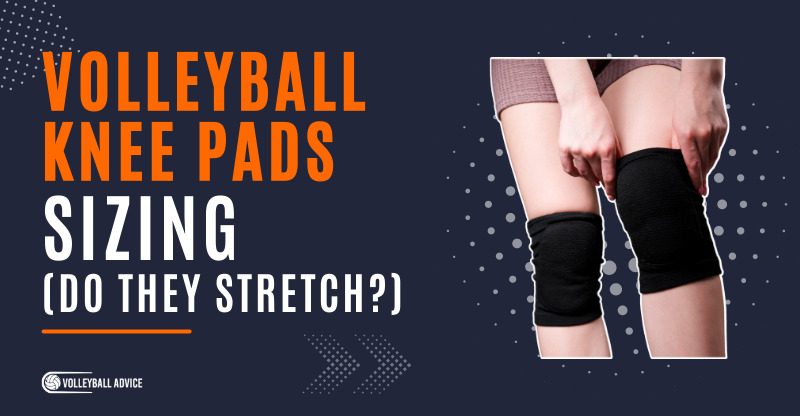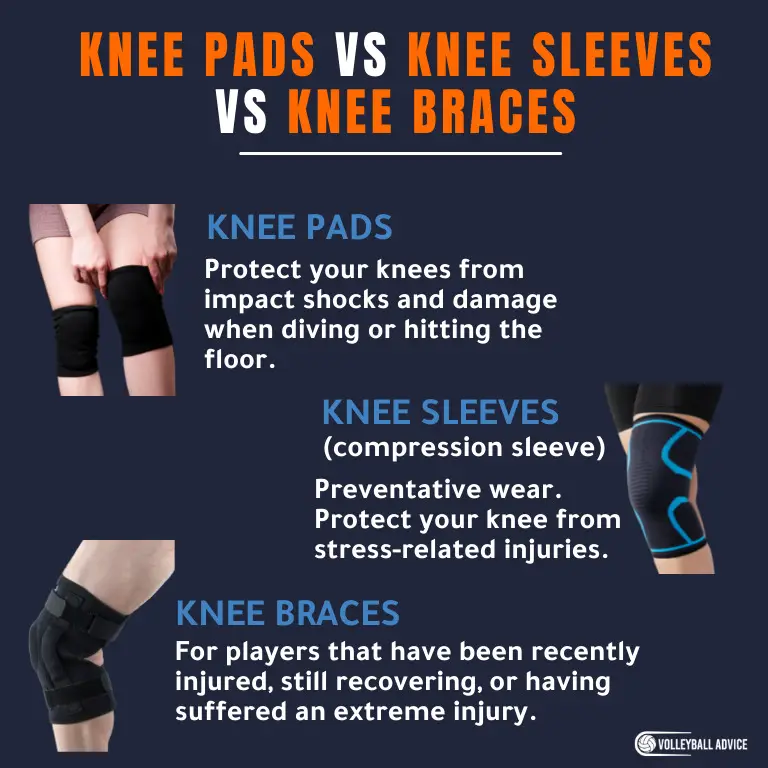Volleyball Knee Pad Sizing (Do They Stretch?)
Some links in this article are affiliate links, which means I earn from qualifying purchases.
When it comes to volleyball knee pads, it’s extremely important that they fit well in order to ensure they are functioning in the right way and keeping you as safe as possible on the court.
Just like other products, volleyball knee pads have sizes and shapes, and getting the right fit will limit the amount of stress your body takes from big dives and slides. Knee pads should be tight enough to stop slippage, comfortable enough to wear for long periods of time, and have no chafing.
Today, I’m going to break down everything about knee pad sizing: their fit, their stretch, and how to measure to make sure you have the best size possible.
Do Volleyball Knee Pads Have Sizes?
Although very limited, volleyball knee pads have sizes and are usually divided into small, medium, or large. Major brands will also include a range from XXS through XL. You may also find “kids” size knee pads, but this usually just means XS.
For reference, I used a Mizuno size medium in high school and university, and this size is still my go-to.
Knees don’t change sizes, so once you’ve found the size that works for you, you’re set. Other teammates of mine used large, and some chose not to wear any at all; it’s purely what feels most comfortable for you.
Should Your Volleyball Knee Pads Be Tight?
Your volleyball knee pads should be tight, but not uncomfortably so. Make sure that your knee pads are tight enough to prevent them from slipping down your leg while playing, as this can cause discomfort and lead to injury.
The other thing you should look for when picking out knee pads is a product that does not irritate your skin on the back of your knee when you move. Some cheap versions (or non-volleyball specific) bunch up and cause irritation and friction burns, which in turn makes playing volleyball simply unpleasant.
Choose knee pads that are comfortably snug, that don’t slip, and won’t chafe your skin.
Related Article: Best Volleyball Knee Pads For Big Legs & Thick Thighs
Do Volleyball Knee Pads Stretch Over Time?
Yes, volleyball knee pads stretch over time – especially when given enough usage.
This is due to the accumulation of sweat and dirt which thins the material, coupled with the regular washing (every two weeks) that committed players should be washing their pads for. The heat from washing under hot water can speed up this process of stretching as well, so always use warm-cold to clean your knee pads.
That said, knee pads are pretty durable. Even with rigorous use and constant stretching, it will usually take over a year for the elastic to break down enough for you to realize that they have stretched. Even then, as long as they do not slide down your leg and provide enough padding, you should be fine to keep using them.
When the elastic weakens enough to regularly slide off your knee or simply makes you feel unsafe, it’s time to replace.
Looking for new knee pads? Check out my article on the Best Volleyball Knee Pads.
If You Have Knee Pads Too Big, How Do You Make Them Smaller?
If your knee pads are too big, I recommend just replacing them.
Knee pads are cheap and easy to find, so there’s no reason why you shouldn’t be able to buy the right size for you. Many stores have a good return policy that might even let you exchange them.
If you really want to shrink them down a size though, the only good way is to use the good old dryer method.
If your knee pads have gel cushioning, avoid using the dryer completely as sometimes the gel can liquidize and ruin the machine.
First, it’s important to note that shrinking your knee pads down works to a limit – in practice, we are attempting to shrink and tighten the elastic, but the padding itself cannot and will not shrink, which can cause problems with actually wearing it.
If you’re still committed, stick your knee pads in the dryer by themselves for about 20 – 30 minutes and then check again for size. If they’re still too large, repeat this step until satisfied.
This is an extremely inaccurate and indefinite way to shrink knee pads, however, and sometimes the elastic will simply start to tear instead of shrink.
Avoid all this trouble and guesswork by just buying a new pair that fits properly.
How To Properly Measure For Knee Pads?
To properly measure for knee pads, use a tailor’s tape (the flexible tape that clothing outlets use that molds easily to the body) and measure the circumference of your knee, around your leg. If you don’t have a tailor’s tape either buy one (they’re cheap) or use a piece of string and measure the intersection.
The point of measuring this is to find the right size for your knee to sit within the molded pads as safely as possible. This is for comfort, but also safety, so it’s a worthwhile thing to do.
While measuring for knee pads is useful, most players just pick a size and guess. As long as the knee pads don’t slip, are comfortable, and don’t chafe, they should be good enough.
Sizing Charts For Volleyball Knee Pads: 3 Brands
Mizuno
Our volleyball knee pad choice, and a product I’ve personally used extensively, is the Mizuno LR6 Volleyball Knee Pads.
They are awesome and although a little more expensive, will last you a long time.
I’ve stuck their sizing chart below for your easy reference:
| SMALL | MEDIUM | LARGE | |
|---|---|---|---|
| Knee Width | 13″ or less | 13 – 15.5″ | 15.5 or more |
KNEEPAD MEASUREMENT: Measure the circumference of your leg at the point where you would wear the top elastic of the knee pad.
Nike
The Nike Essentials Volleyball Knee Pads are another great product we recommended, so here is another useful sizing chart for Nike products!
| EXTRA SMALL | SMALL | MEDIUM | LARGE | |
|---|---|---|---|---|
| Knee Width | 13″ – 15.5″ (33-39 cm) |
18 .5″ (39-47 cm) |
18.5″ – 21″ (47-53 cm) |
23.5″ (53-60 cm) |
| 12″-13″ (30-33 cm) |
13″-14″ (33-35 cm) |
14″-15″ (35-38 cm) |
15″-17″ (38-43 cm) |
If you don’t have a measuring tape, here is a rough approximation based on weight:
- 70~100 lbs = XS/S
- 100~130 lbs = M/ML
- 130lbs and up = L/XL
Asics
Asics knee pads predominantly focus on the “one size fits all” mentality, which while making them less desirable for high levels of play actually work well for first getting into the sport of volleyball.
The actual size of them are simply mediums, for anyone wondering – they just have slightly more “give and take” than your other brands of knee pads.
The ASICS Ace Low Profile knee pads are our choice if you’re going to buy from Asics, so check them out below!
Differences: Knee Pads vs Knee Sleeves vs Knee Braces?
Knee pads, sleeves, and braces are all useful tools to keep your body safe, but sometimes it can be confusing when and if to wear them. Let’s break down their differences.
Knee Pads
These are to protect your knees from impact shocks and damage when diving or hitting the floor and are highly recommended for most volleyball players. Cheap and cost effective, they can be worn over knee sleeves if needed.
Knee Sleeves
Preventative wear, these are to protect your knee from stress-related injuries, such as jumper’s knee and tendonitis. Also known as a “compression sleeve”, this is an amazingly useful tool for anyone with recurring pain inside their knee or having a history of knee pain (or these aforementioned conditions).
Knee Braces
A more extreme support system than knee sleeves, braces are usually for players that have been recently injured, still recovering, or having suffered an extreme injury to your knee such as breaking the bone or tearing your ACL.
This device provides amazing support to your knee and is one of the best tools for being able to play after a serious injury. Depending on your goal, braces can either be worn continuously for your playing career, or for a short time to address specific concerns.
Talk to your coach, physical trainer, or doctor about whether this is right for you.
Frequently Asked Questions (FAQs)
How Do You Stop Your Knee Pads From Slipping Down?
If your knee pads fit properly, they will keep themselves from slipping down. I highly recommend just buying a pair that fits properly to solve this problem.
What To Read Next:
- How to Wash Volleyball Knee Pads Without Wrecking Them
- How Long Do Volleyball Knee Pads Last? (Honest Perspective)
- How Much Do Volleyball Knee Pads Cost? (Breakdown Per Brand)
- What Are Volleyball Knee Pads Made Of? (Materials Explained)
- Volleyball vs Basketball Knee Pads: Differences, Pros, Cons
- Best Volleyball Knee Pads For Liberos
About The Author
Ailan Samuel is a writer and athlete who has played volleyball at the university, club, and national level since 2012. He has competed successfully in both beach and indoor competitions, resulting in four silver and two gold medals, and was awarded the Half-Blue while playing in Scotland. He received his MA in English and Medieval History from the University of St Andrews, Scotland, and is currently studying for his MA in Publishing and Creative Writing at Bournemouth University.


